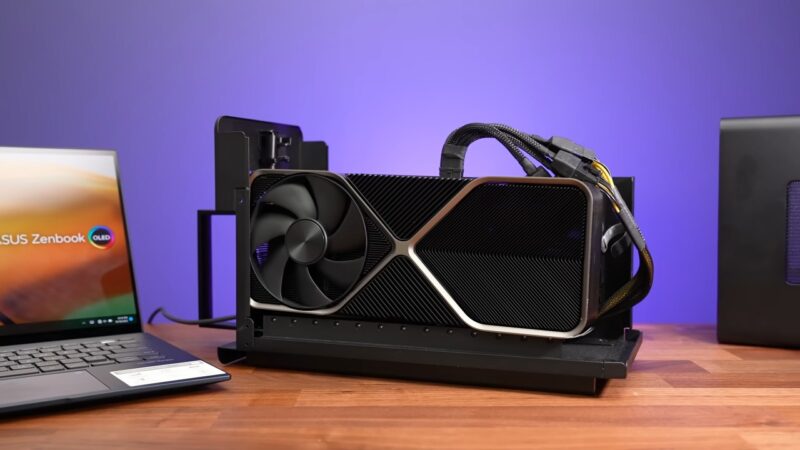Gaming laptops are a good option if the owner really needs the portability. A decent gaming laptop can be used for regular office tasks and gaming, but as games get more demanding, there are few ways around upgrading your parts. But it is even possible to upgrade parts in a gaming laptop?
Gaming Laptops like the Alienware AREA-51M that allow upgrading parts such as the CPU or GPU are a lot more expensive than regular systems. This gaming laptop enables you to use standard processors like the 10th Gen Intel® Core™ i9 10900K, and choose between AMD or Nvidia graphic options.
Unfortunately, with a price of $2,299.99, the Alienware AREA-51M is definitely a high-end gaming system, and probably too expensive for most gamer out there. Also, this is only the “Basic” version of the 51M, as the most potent version costs $4,699.99. Click here if you want to learn why gaming laptops are so expensive.
Sure, there are also other companies that offer gaming laptops with the option for upgrades, but almost all of them cost more than a desktop version with the same components. Regular gaming PCs are much easier to upgrade and customize than gaming laptops, as PC cases offer enough space for new additions and changes.
If you want a new graphics card (GPU), you only have to unplug two power cables, open both safety clips on the motherboard, and then pull out the graphics card. Most of the time, you cannot even change the GPU of a gaming laptop because it is integrated into the motherboard.
Luckily, there is another way on how you can upgrade your gaming laptop: using external hardware. Especially an eGPU is an excellent way to make your gaming laptop more potent. Laptops that have a less powerful graphics card built-in are not capable of running demanding games like Tomb Rider on decent settings. But if you put a regular PC graphics card into an eGPU housing like the Razer Core X, you can use the PC graphics card’s power.
Which Parts Can Be Upgraded In A Gaming Laptop?

A gaming laptop is created out of many smaller components, such as cables, storage drives, fans, antennas, chipsets, motherboards, heat syncs, and more. When upgrading a gaming laptop or a regular gaming PC, not every part can/has to be upgraded for increased performance. In gaming laptops, only a few parts can be upgraded or replaced:
- Graphics Card (GPU)
- Processor (CPU)
- SSD and HDD drives
- Random-Access-Memory (RAM)
- WiFi Antennas
- Displays
Unfortunately, not every gaming laptop can take upgrading parts, like the Alienware AREA-51M. Usually, you are limited to upgrading to more powerful SSD and HDD drives and adding more RAM.
If you have enough knowledge in modding and building laptops, you could craft a more powerful system with enough work and time invested. However, this way is only available for people with lots of experience in the field, and not for a casual gamer/PC user.
Can You Add More RAM To A Gaming Laptop?

Newly released games or games with higher system requirements usually require 8GB of RAM (Random-Access-Memory). However, if a system only has a few gigabytes of RAM available, more demanding games can’t run properly anymore and start to lag, crash, or won’t start at all. So, upgrading to more RAM is a good decision, to be able to play more demanding games like Call of Duty: Modern Warfare.
To upgrade the RAM in a gaming laptop, open the system’s backside to get access to the memory banks. Make sure the laptop is turned off and unplugged, to prevent technical problems and damaging parts. To remove an existing RAM stick, push apart both clips, and pull out the stick afterward.
When adding new RAM, insert the new modules into the open slots at a 45-degree angle, and push them into place. If the RAM is installed correctly, you should hear a click from the security clips. After installing new RAM modules, close the backside of the laptop, and start the system.
Start the Task Manager, click on performance, and select memory in the right sidebar. At the bottom, you can see how many slots are currently used and how much RAM is detected.
Popular RAM for gaming laptops are the Corsair Vengeance performance memory kits with 2x 4GB DDR4 2666Mhz. Generally, it is recommended to only run dual-channel setups, as it performs much better than single-channel setups. Click here to see current prices on Amazon.
Can You Upgrade A Gaming Laptop GPU?
Changing to a newer GPU model can increase the system’s power immediately. In a regular gaming PC, the GPU can be replaced in a couple of seconds, but it is much more difficult in gaming laptops.
However, installing a more powerful GPU increases heat production, and thus, can damage other parts. In addition, the cooling system is only optimized for the original GPU. Another fact that makes it difficult to upgrade to a more potent GPU is that there are almost no cards available on the market.
If you want more GPU power in your gaming system, buying a new laptop with a stronger graphics card is recommended.
Do Gaming Laptops Last Long?
Because of the limited options for upgrading parts, a standard system at a price range of $800-$1,200 can last for 2-3 years of gaming. However, if the system has to run on maximum performance, chances are high that the system won’t last as long. Going for a future proof gaming setup with high specifications makes sure the system can run all current and future games without running on max performance.
The average life span of a gaming laptop is 2-3 years. After this time frame, components lose power and become slower, which results in lower FPS, longer loading times, slower boot up, and more. During a gaming session, the battery also heats up, which may shorten the overall lifespan of it and other components.
To increase a gaming laptop’s life span, the laptop should not run on high temperatures and have to use 100% of its power. Also, cleaning the laptop from dust and other dirt helps keep the system clean and on lower temperatures.
If you want to use your gaming laptop as long as possible, upgrading the RAM, switching from HDD to SSD units, and overclocking (if possible), the graphics card can help get a bump in performance.
Going for more powerful parts like an Nvidia GeForce RTX 2080 doesn’t mean that the gaming laptop will last longer if it has to use all available resources and runs on high temperatures all the time. However, a balanced system with decent specs will guarantee a few years of good gaming experience.
What’s all the Hullabaloo About eGPUs?
To start off, what on Earth is an eGPU? No, it’s not an electronic goose pecking away at your laptop! It’s an External Graphics Processing Unit. You may know how a standard GPU accelerates your laptop’s performance, rendering sublime visuals for immersive gaming. An eGPU is a freestanding unit that turbo-charges your gaming laptop, in a manner of speaking, without popping the hood!
Why the Need for eGPUs?

Now, you might be thinking, why should I lug around this added bit of tech? Gaming laptops are beefy in their own right, but let’s face it, they often lag behind their desktop brethren when it comes to graphics performance. The culprit? The compact design of laptops that restrains the GPU’s power potential.
Enter the eGPU – your one-way ticket to high-performance gaming on your laptop. It provides additional horsepower to smoothly run graphically-demanding games, VR applications, and other heavy-duty tasks. It’s like having a bowl of hot chili on a cold winter’s night – a spicy addition to warm you up!
The Installation Dance
Got your eGPU ready to roll? Excellent! Now let’s pirouette through the installation process. First, connect the eGPU enclosure to your laptop via the Thunderbolt 3 cable. Once your laptop acknowledges this new entrant, install the necessary drivers. After a quick restart, your laptop and eGPU should be best friends, ready to face the gaming world together!
Potential Hiccups Along the Way
Despite the rave about eGPUs, there are potential bumps in the road. Sometimes, the laptop may not recognize the eGPU – like an awkward encounter between two introverts at a party! Compatibility issues could arise, or the performance might not meet your expectations. It’s essential to research and plan accordingly, so you’re not caught off guard.







